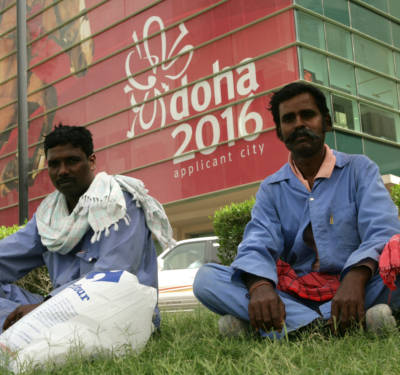Qatar’s immigrants at higher risk of diabetes
South Asian and Filipino populations in Qatar may be more likely than their Arab counterpart to present with type 2 diabetes.
Published online 31 May 2015

Qatar is home to a large population of immigrants mainly from South Asia.
© Alan Gignoux / Alamy
Elevated levels of glycated haemoglobin can identify individuals with undiagnosed type 2 diabetes (T2D) in Qatar’s South Asian and Filipino immigrant population, according to a study published recently in the Qatar Medical Journal1.
Qatar and the rest of the Middle East have among the highest prevalence of T2D in the world, and it is estimated that up to one quarter of people with the disease remain undiagnosed.
An increase in blood plasma concentration of glycated haemoglobin is indicative of T2D and also of the pre-diabetic state, and so Karsten Suhre of Weill Cornell Medical College in Doha and his colleagues wanted to determine if this could also identify undiagnosed individuals.
The researchers recruited 191 participants with no record of T2D, measured their glycated haemoglobin levels and used a questionnaire to obtain socio-demographic information about them, such as age, gender, ethnicity and level of educational attainment.
They found that one fifth of the study participants had elevated glycated haemoglobin levels, but more significantly, there were large differences between the ethnic groups studied. Those of South Asian descent had a 13-fold increased risk of having elevated glycated haemoglobin levels, and Filipinos a 4.5-fold increase, compared to the native Arab population.
Of the South Asian and Filipino participants, 38% had glycated haemoglobin levels of more than 6%, which is indicative of impaired glucose metabolism or undiagnosed T2D. These differences have been observed before, but are usually attributed to differences in access to, and the quality of, medical care.
Because T2D is often associated with obesity, one might predict that the Arab participants, who had, on average, markedly higher body mass index (BMI) and waist circumference measures than the others, would exhibit high levels of glycated haemoglobin.
The results, however, suggest that Qatar’s immigrant population has a significantly increased risk of having undiagnosed T2D, and that glycated haemoglobin levels could be a useful diagnostic tool for early detection of the disease.
The researchers stress, however, that their preliminary results should be confirmed in future studies involving larger numbers of participants.
“We would advise the Qatari government to screen all immigrants entering the country, as this would decrease the risk of unnecessary complications due to the late diagnosis of diabetes,” says lead author Dennis Mook-Nakamori. “We are currently assessing novel tools for a larger scale, quick and non-invasive screening programme for diabetes in the Qatari population."
Reference
- Mook-Kanamori, M. J., El-Din Selim, M. M., Takiddin, A. H., Al-Mahmoud, K. A. S., Al-Homsi, H., et al. Elevated HbA1c levels in individuals not diagnosed with type 2 diabetes in Qatar: a pilot study. Qatar Med. J. 2014, 17 (2014). | article
DOI: 10.1038/qsh.2015.64

